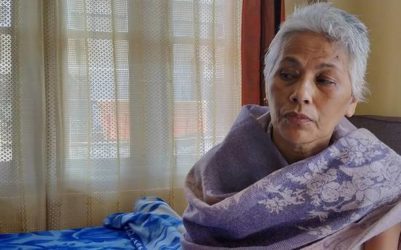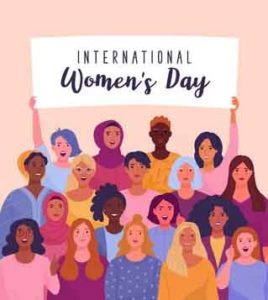By Esha Chaudhuri
 As we approach International Women’s Day, it is that time of the year, when we reflect on the lives of women dwelling upon the public versus private spheres, the drudgeries of day to day living vis-à-vis the performativity of gender roles. However, because of the existence of the matrilineal way of life in the state granting leeway to its women in comparison to patriarchal societies, it often draws speculation as to where are its women headed. Speaking with three notable women in the field, Sunday Shillong unravels the challenges in the different arenas of the lives of the women of Meghalaya.
As we approach International Women’s Day, it is that time of the year, when we reflect on the lives of women dwelling upon the public versus private spheres, the drudgeries of day to day living vis-à-vis the performativity of gender roles. However, because of the existence of the matrilineal way of life in the state granting leeway to its women in comparison to patriarchal societies, it often draws speculation as to where are its women headed. Speaking with three notable women in the field, Sunday Shillong unravels the challenges in the different arenas of the lives of the women of Meghalaya.

Angela Rangad, Social Activist, Thma U Rangli Juki speaks on “The economic situation of women in Meghalaya”
I think we need to understand that the “economic condition or situation of women” is linked to the “position of women” in a society and that economic uplifting alone will not secure women’s overall empowerment. There is a need to emphasize that in matrilineal Meghalaya, women may be more visible in the market place and other public spaces but statistics reveal that women are increasingly becoming landless and disenfranchised. This, along with failing agriculture has greatly impacted their independence and livelihood abilities as farmers in the traditional setup. This has further led to internal migrations into the city where these women then take up low paying and insecure informal sector work including those as domestic workers and hawkers.
 Many of these women are single mothers trying to eke out a living for their families where the state has abdicated all responsibility in ensuring basic social sector rights such as health care, education and housing. Many a time, their earnings continue to be hand to mouth, as they have no additional assistance and social security. When it comes to the formal sector work force, we do find many women especially in the government sector but even here, most positions are of a contractual and casual nature and not accorded full workers rights and security.
Many of these women are single mothers trying to eke out a living for their families where the state has abdicated all responsibility in ensuring basic social sector rights such as health care, education and housing. Many a time, their earnings continue to be hand to mouth, as they have no additional assistance and social security. When it comes to the formal sector work force, we do find many women especially in the government sector but even here, most positions are of a contractual and casual nature and not accorded full workers rights and security.
Sexual harassment at the workplace is also a reality in our state but the law on it is not being properly implemented. Internal complaints committees on sexual harassment are still not set up and the district level complaints committees are dysfunctional. However we need to be reminded of the fact that when the question of economic participation of women is asked, without the unaccounted invisible work that women do in the house and in social  reproduction of society there will be no economy to talk of.
reproduction of society there will be no economy to talk of.
Additionally we must also focus the spotlight on the most important question when it comes to empowerment of women. That being that without ensuring their full participation in decision making at the grassroots level and the Dorbars and encouraging their political participation, the status quo will remain.
If we remember the origins of the 8th March celebrations to highlight the “particular oppression of women and honour their struggle for equal rights”, then it becomes easy to understand our tasks in matrilineal Meghalaya. The matrilineal nature of our indigenous communities have been for too long used as an excuse by the community and state patriarchs to deny everyday misogyny that indigenous women face. Matriliny, which allows for lineage through the mother and a certain level of property rights for daughters has meant that some community leaders deny that indigenous Khasi, Pnar, Achik women face any discrimination and oppression. In the name of tradition, the same community leaders and institutions, the same community leaders and institutions actively have kept out half of our community from fully participating in local self-governance.
As a socialist feminist Khasi, I believe that no notion of identity can base itself on oppressive traditions and I am not alone in this fight to reconfigure tradition to incorporate gender just and egalitarian ideas in indigenous institutions and culture. From villages like Nohwet to Jongksha, from Mawlai to Bishnupur, Khasi women have been raising their voice to carve out their rightful place in local self-government and struggled to dismantle the decaying patriarchal institutions and attitudes. I firmly believe that indigenous woman would soon head local self-government structures like Dorbar and this will better ensure women’s agency overall including in the economic sphere.

Agnes Kharshiing, Women’s Rights Activist comments on “The Plight of Women in the State”
It is known to all that despite being a matrilineal society, many women in Meghalaya are still struggling for their space and respect in society. There are some villages in the state wherein women are not allowed in the Dorbar. With respect to the crime scene, in some instances when cases are filed against rape, especially when the perpetrators are related to the traditional heads then the victim and her family are rebuked, ignored and cases linger on. Many women are trapped in their economic status too. If they struggle hard, protect their land, protect environment, their relatives are assaulted and there is no respect, one such is the recent example of Nengchigen Nokma when she protected her clan land. The apathy against women looms large – when women activists speak out on corruption, illegal activities, they are called names, threatened on social media by their own people from the same community. As an activist myself along with others, inclined towards transparency and accountability, questioning the MNREGS projects in their villages, we face tremendous pressure for what we do – speaking the truth. But I do believe that there is hope and determination for women in Meghalaya and I hope we can see bright spaces, equal respect for all women in the society.
 Philadalia Toi, Chairperson Meghalaya State Women’s Commission shares her views on “Representation of women in Positions of Power”
Philadalia Toi, Chairperson Meghalaya State Women’s Commission shares her views on “Representation of women in Positions of Power”
There is a great deal of misconception regarding what a matrilineal society really is. Often, a matrilineal society is confused with a matriarchal society, where the power lies with the women, but in the former, it is generally limited to lineage in kinship and inheritance of property and titles. However, even with regards to ancestral property, a woman can take no decision without consulting with her uncles. Since times immemorial, the men have held all positions of power. Although women in our society enjoy more freedom at home and society at large compared to patriarchal societies, yet it is still does have aspects of male dominion in many respects. At home, the father is still considered as the head of a nuclear family and the eldest uncle as the head of a joint family or matri-local families. Historically, political empowerment of women is not encouraged and traditionally, only men are allowed to contest for Syiemship, Nokmaship or Doloiship. Even at the local governing institutions such as the Dorbar Shnong, only men are either elected or selected as headmen of localities.
Today, we see women are in power in almost every domain with the exception of political  power, which is in fact, the poorest of all states.
power, which is in fact, the poorest of all states.
Time changes but the mindset still remains the same. “Daddy brings money, mummy makes honey” is becoming outdated in today’s time. But the society still sticks to the outdated mindset because this gender bias has been entrenched by sayings like “Lada ka syiar kynthei kan kyn’ih, ka pyrthei kan sa wai” (The world will come to an end if the hen crows). But in reality the women have moved forward to play a double role – to bring money and make honey for the family. Women have advanced to contest elections and the aversion to women candidates has begun to wear off bit a little. It will take time but I am hopeful.
Given the different facets of women’s lives and their roles in their private lives and their limited access to the public, gendered acts of “Ka Bha briew” is enacted and recycled in different forms hence equating women of matrilineal societies with those of staunch patriarchal ones; despite their seemingly freer ways. As it can be inferred, it takes collective effort on the part of men and women to reach a functional and holistic way of life harmonious for all genders. Which otherwise leaves us with the pertinent question – where are our women?



